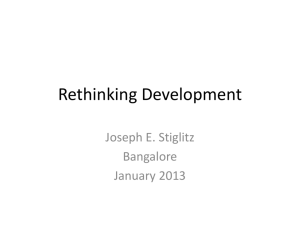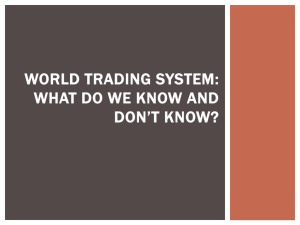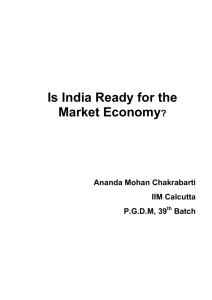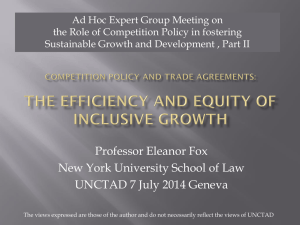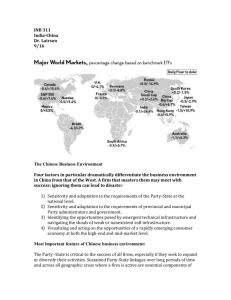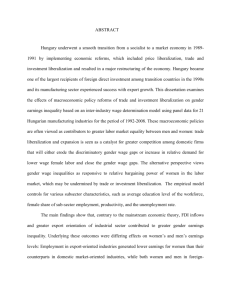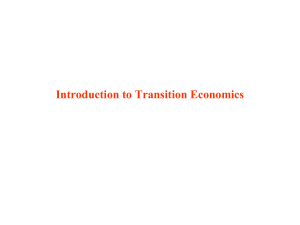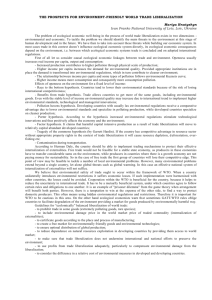Lecture 17
advertisement
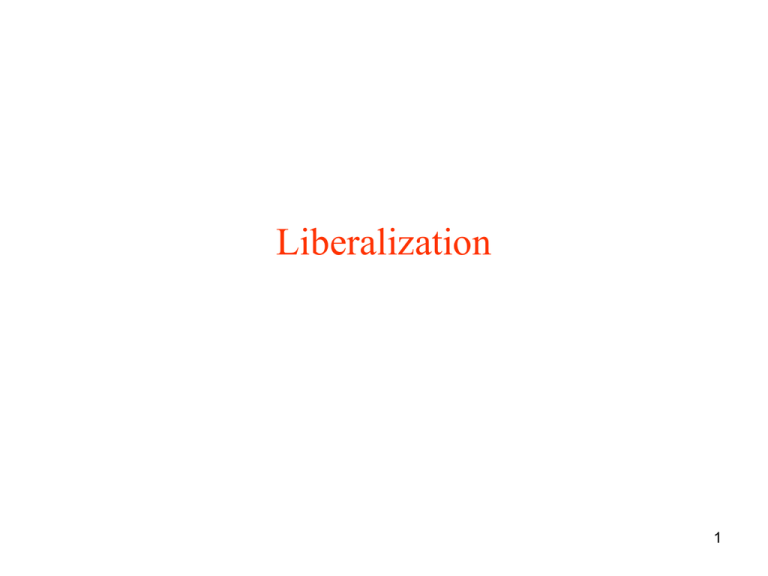
Liberalization 1 1. Introduction – Liberalization is one of the fundamental elements of transition. As the planned economy is one of extensive controls, the first step in the transition to a market economy is to lift these controls: • – – Planned economies enacted controls both domestically and internationally. Replacement of command elements of an econ system by decentralized market type elements through privatization and reduction of government intervention. Domestic liberalization • involves lifting price controls and providing economic agents freedom of enterprise – – reducing subsidies to consumer and producer prices, w/ exception of housing utilities and energy prices that were to be freed several years later External liberalization • involves the lifting of controls on trade, unifying the exchange rate, and allowing the exchange rate to achieve its proper level, either through devaluation or by gradual adjustment. 2 2. Domestic liberalization a) Price Liberalization – One of the fundamental actions in transition is price liberalization. Transition economies inherit a system of arbitrary prices, and the lack of information signals in these prices is a (the) key source of inefficiency in the economy. Moreover, with the abolition of central planning decentralized decision making is enhanced, even before privatization takes place. Therefore it is crucial to liberalize prices. – Problems associated with price liberalization. • First, if the economy is still dominated by state-owned enterprises it is not clear that liberalized prices will be market prices. – A key question is whether the state-owned enterprises will be subject to soft or hard budget constraints. But it also is related to the objectives of the SOE; are they primarily government agencies or independent entities worried about their own profits. • The second problem with price liberalization is the price shock – as socialism collapsed the loss of control by the center led to wage explosions and a monetary overhang. » A monetary overhang refers to the excess of money assets held by the population compared to the nominal value of goods available. 3 b) Price Liberalization and Welfare • The conventional view is that living standards have fallen dramatically, owing to price liberalization. – Since nominal wages have risen much less than prices, the claim is made that living standards of the population have fallen, by as much as 50%. This claim is almost certainly wrong. Let us examine why. » Liberalization involves a movement from an excess demand regime to an excess supply regime. The reduction in real income that occurred simultaneously does not imply a similar reduction in welfare. The reason is that the reduction in excess demand eliminates welfare-reducing activities, such as queuing, that are not included in real income, but are directly related to it. The real change in living standards has occurred on the extremes of the economy » There are greater opportunities to be rich, and there is more hardship for those on fixed incomes. 4 » Since pensions did not keep up with prices, those that were dependent on this source of income were the most hurt. This is, however, a transfer, not an aggregate impoverishment. » Notice that the impact effects of price liberalization may have important distributional consequences. With controlled prices excess demand leads to rationing. When prices are freed queues are eliminated. This results in a transfer from those endowed with time to those who have higher incomes. The elderly, for example, have a low opportunity cost of time, so queue-rationing results in their collection of rents. These are lost when prices are liberalized, and the biggest beneficiaries of this are those who have a higher opportunity cost of time, typically those who are highly paid. » In general, price liberalization hurts the less affluent b/c under the administered prices they had an access to goods on the same basis as everyone else & b/c of their marginal value of time was low, the queuing system worked on their benefit. Liberalized Prices confront time w/ a hard monetary budget constraint & cause a fall in living standards, a case of the efficiency of the mkt conflicting w/ the greater equity of non price allocation. 5 • While there may be distributional consequences, the overall gains from price liberalization are positive. Removing distortions leads to more efficient allocation of resources. This leads to net gains for society, as subsidies and/or queuing is reduced. 6 c) Liberalization and Inflation – In all countries the immediate effect of liberalization was an acceleration of prices. The sequel was high inflation. What is the link between price liberalization and inflation? • The fundamental issue is whether inflation is due to monetary (money ss) or structural factors (due to transition). The structural argument about inflation is that the fall in production is the primary cause of inflation. According to this view the decline in output that follows liberalization is the cause of inflation. Related to this view is the argument that energyprice liberalization is an important factor in inflation. The problem here is the failure to distinguish between changes in the price level and changes in relative prices. • Inflation is sustained increases in the level of prices. • Liberalization necessarily involves changes in relative prices because of the distortions inherited from planning – Liberalization is necessary • to relieve repressed inflation (Repressed inflation means price level is below market-clearing => shortages, queuing, black markets) • Monetary overhang • Necessary because of arbitrary pricing – Prices must be deregulated to let the market work 7 • Price liberalization led to price explosion • Reason why inflation explodes 1. Removal of price controls 2. Monetary financing of deficits 3. Credit expansion to support enterprises—Soft budget constraints 4. Monetary overhang--Spending of forced savings • Although inflation is costly, it does make relative price adjustment easier 8 Energy Price Liberalization. Liberalization of energy prices is an especially important issue in transition because of the characteristic under-pricing of energy in planned economies. In a country like Russia, which is a large producer of energy, under-pricing leads to higher domestic consumption. Liberalization means lower domestic consumption and higher exports of energy. Consumers lose and producers gain, but the overall effect is positive. To see this, consider the simple case where the domestic supply is fixed, and where the price is controlled, at p’, below the world market price, p*. Domestic supply is fixed (S), and the price is controlled, at p’, below the world market price, p*. P S p* p’ D 9 • Suppose further that the excess demand at the controlled prices is financed by imports at the higher world price. The government is thus subsidizing domestic consumption. When prices are liberalized consumers lose the area p’p*ab plus the area abc in the Figure. But the elimination of subsidies means that the government gains the area p’p*ab plus 2 times the area abc. So the net welfare gain to society is the area abc. • Producers who have capital stocks that are highly energy intensive are unable to adjust rapidly to market prices. Forcing them to pay higher energy prices may make these enterprises unviable. • Households, meanwhile, may not be able to afford the true cost of energy, given how energy-inefficient their housing. • The political cost of liberalizing energy prices may be very high. 10 3. External Liberalization; Reform of International Trade and Finance Integration with the international economy is an essential element of the transition from central planning to a market system. Price distortions, so common under central planning, could be maintained only through formidable trade and foreign exchange controls that divorced the domestic from the international market a.) Definitions • International trade – the sale by one nation to another of capital equipment such as tools, machines, supplies, or consumer goods etc. • International capital movement – refers to borrowing and lending between countries. • Capital account – the sale and purchase of assets among nations (borrowing and landing among nations) • Current account – imports and exports of goods and services, along with income generated from investments and transfers • Capital account convertibility – exists when a currency can be purchased and sold in a market for the purpose of engaging in transactions pertaining to assets or the capital account • Current account convertibility – exists when a currency can be purchased and sold in a market for the purpose of engaging in transactions pertaining to the current account 11 b). International trade in the early years of transition • Under command economies – State control of foreign trade; – Nonconvertible currency – Barter trade. • Problems with replacing state trading systems – need for a convertible currency so as to move away from barter arrangements through state trading organizations • Convertible currency--currency for which there is a mkt(ss&dd) & thus a mkt determined rate of exchange, available to all participants inside and outside a country. – problem of choosing exchange rate regime to maintain balance of payments without severe unemployment – need for financial markets to allow inflow of foreign capital- portfolio investment or foreign direct investment 12 • Reforms – As transition began in the early 1990’s attention focused on the appropriate organizational changes and associated policy measures that would lead to liberalization in foreign trade, or the opening of largely “closed” economies to pursue integration w/ western mkt economies. – There is a close relation b/w the foreign sector and the domestic sector and this relation is especially fragile in the trans econ’s. • The domestic monetary and fiscal policies must both be coordinated w/ the financial arrangements in the foreign trade sector. • The exchange rate regime is the fundamental link b/w the domestic econ and the external econ, the goal being to provide a nominal anchor, to ensure adequate competitiveness, and to insulate the econ from shocks. • Choosing an exchange rate regime became very difficult. – Trade liberalization sharply reduced role for the state in the conduct of international trade • As the state exited from the active management of the econ’s, liberalization would imply the replacement of state trading organizations by private organizations, including banking and financial organ’s. There will be an effort to reduce restrictions on foreign trade-both quantitative (import and export quotas) and financial restrictions (import and export tariffs). 13 – A key reform is elimination of the FTM (foreign trade monopoly); unifying the exchange rate; and allowing current account convertibility. • Elimination of the FTM is a rather obvious reform. As long as this exists producers are insulated from external influence. • Unification of the exchange rate is also an obvious reform. Under planning there were many different implicit export taxes and subsidies. Export taxes were levied on energy and other raw materials that were underpriced. Import subsidies were provided for essential imports. With a unified exchange rate (unified system of export taxes and import subsidies) producers can compare domestic and world relative prices. – Exchange rate unification will not have its effects on production without current account convertibility. • This is the requirement that exporters and importers have access to foreign exchange. If foreign exchange is rationed then world market prices are not the effective prices. • The key point here is convertibility of the current account (imports, exports of goods and services). This means that foreign exchange can be obtained for current, as opposed to capital (assets), transactions. – There is a reason why transition economies may wish to maintain some level of protection. It is the fiscal dimension. Some countries obtain a rather large share of revenue from customs duties. • Establishment of a convertible currency – and of an exchange rate regime that could sustain external balance and internal balance; • the initial step was the introduction of current-account convertibility, followed 14 later by capital-account convertibility. c). Exchange rate regimes • Exchange Rate – the number of units of currency of a country that trade 1 unit of another country such as US$. The monetary regimes adopted in transition economies varied considerably • a flexible exchange rate – the exchange rate adjusts to bring equilibrium to the balance of payments-that is the inflow and outflows of capital • a fixed (pegged) exchange regime – currency value is matched to another single currency; the adjustment takes place through changes in the domestic money supply • currency board – money supply is tied to the level of foreign exchange reserves, as the CB must back all issuances of money by its existing reserves. The government could thus no longer cover the budget deficit, bailout loss making enterprises or rescue troubled banks through money printing. 15 • Should transition economies have fixed or flexible exchange rates? Should they have a currency board. • All have been utilized by different transition economies. There is no perfect choice. – One of the arguments for a fixed exchange rate is to serve as a nominal anchor. We have seen that inflation is often a problem in the early period of transition. One reason why it is so hard to curtail inflation is that once prices start to accelerate expectations of future price increases reduce the nominal demand for money; in other words velocity increases. This means that inflation will rise even if the money supply does not grow any faster. To stabilize the price level it is important to change expectations. A fixed exchange rate (the system of international payments in which a country pegs the rate at which its currency exchanges against another currency such as US$, by buying or selling its currency the central bank would limit variations in ER to a narrow range) may help change expectations, if the peg is credible. If the peg can be sustained, and if inflationary expectations stabilize then inflation will also stabilize and growth can start. Many fast reforming economies, such as Poland, Czech republic, chose this path. 16 – One may then ask why not always start with a fixed peg? One problem is that if inflation is higher than in the rest of the world a fixed rate will become over-valued over time. This will reduce competitiveness, and it will require devaluation. But this becomes a political issue. A flexible rate eliminates this problem. The rate adjusts to market conditions. • In Russia a flexible rate in the early period of transition was accompanied by high inflation. – The question, of course, is how to make the peg credible? A currency board is often a solution that adds credibility to a fixed rate. • In Estonia a currency board has been a great success. • In Bulgaria as a result the inflation decreased and the budget deficit was cut significantly. 17 • Balance of payments – includes the current account and the capital account. • If the sum of both is zero, the quantity of foreign exchange being demanded is equal to the quantity of foreign exchange being supplied. • An imbalance implies an adjustment process, a change in exchange rate assuming that a flexible exchange rate regime is in place. • The opening to external trade has been accompanied by rising current account deficits. 18 d). Financial (capital) flows • Capital flows—form of aid, portfolio investment or foreign direct investment • Aid —IMF and World Bank. • FDI—Per capita FDI in the former republics of the Soviet Union and the major economies of Eastern Europe, when measured in U.S. dollars, has differed considerably in amount from one country to another. Why? Key determinants for FDI in transition economies: – Low country risk assessment. – Functional and effective legal framework • Well-defined property rights • Consistent tax laws – Reasonable resource base and an infrastructure appropriable to the sort of investment being contemplated. – Unit labor costs. • Increasing global competition to attract FDI. • Many governments have employed incentives to attract FDI: – Corporate tax cuts (Estonia) – Investment incentives including tax discounts, training grants, infrastructure upgrades (Czech, Slovakia) – Discretionary tax breaks and customs duty exemptions for government agreed projects (Bulgaria, Romania) • In recent years much FDI has taken place in the form of multinational enterprises. 19 • Major share in FDI inflows: – The automotive industry • • • • • • • German FDI: – Manufacturing (Czech, Hungary, Poland, Slovak, Slovenia, etc.) • • • • • – • Polsky (Fiat) Wartburg (GM-Opel) Trabant, Skoda (VW) Slovenian IMV (Renault) Daiwoo in Poland and Romania Suzuki in Hungary Food processing (Slovenia) Transport equipment (Czech and Hungary) Metal industry (Romania) Chemical industry (Bulgaria) Wood and wood product industry (Romania and Lithuania) Services (financial, real estate-Poland) Capital flows have increased significantly in EE and more slowly in the CIS. 20 21 22 23 24 e). Trading Agreements. 1. By 1996 all became members of the World Trade Organization (WTO) and the General Agreement on Tariffs and Trade (GATT). 2. Accession to the EU is a common goal of many transition economies – 10 countries became member on 5/1/2004 – 2 countries became member on 1/1/2007. 25
